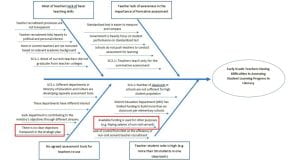Guest blog written by George Adam Sukoco Sikatan, Lanny Octavia, Sarah Ayu, Wahyu Setioko
This is a team of development practitioners who work for INOVASI and DFAT in Indonesia. They successfully completed the 15-week Practice of PDIA online course that ended in May 2019. This is their story.

It is at last the final week of the course, and we say this full of gratitude and relief. None of us had anticipated just how intense and demanding this course was going to be, from the essential (and optional) reading, individual and groups assignments, to reflection exercises and graded discussions; needless to say they were onerous! At the same time, the abundance of knowledge was exciting and overwhelming.
Working in the public/development sector, in a large, populous country such as Indonesia, the 4 of us often come across bewildering, deeply rooted problems that seem just impossible to resolve. The PDIA approach shines a positive light on this situation and more importantly, confidence to overcome them. We learned to deconstruct a problem into smaller pieces and find the root cause using a relatively simple, yet powerful, tool namely the 3A analysis (Authority, Acceptance and Ability).
Another key takeaway from our group is the importance of reflective process to help us look into failures, challenges and feedback as opportunity to grow and construct (or when necessary, deconstruct all over). This methodology taught us to become better listeners, to arrive in a situation with an open mind instead of a will to impose external practices. These reflections and adaptations to the local context, allow us to remain relevant both to the problem that we are trying to solve and towards our beneficiaries.
This course also reminded us of the importance of collaboration and coordination with a broad range of stakeholders. We understand now that multiple perspectives, incentives and even interests are actually useful in defining problems and formulating solutions. Sharing a common goal at the beginning of the work had founded a sense of belonging and motivation for all team members, even when the time is hard and problem becomes more challenging.
Perhaps one of the most important lessons from this course is that we cannot do business as usual when trying to work out complex, wicked hard problems. There is a fascinating metaphor we learned here, “You cannot cross a chasm in two small jumps. If your first jump fails, the second jump is from the bottom of the chasm and your legs are broken.” (p. 73-74). We know now that there is only a slim chance of success from trying to do same thing twice and thinking that the results will be different. The iterations, capacity building and reflections offered by the PDIA process allow us to do the second jump differently.
Our group’s problem was that early grade teachers are having difficulties in assessing students’ learning progress in literacy. We learned straightway that even defining the problem was not as simple when using the PDIA approach, but it will likely be less generic and more accurate. Initially we had thought that the teachers’ incapability was due to the lack of basic teaching skills, in which case it seemed that trainings were the direct solution. However, once the problem was deconstructed, we found that there are also other influencing aspect namely teacher recruitment process, the government’s objective framework for basic education, budget allocation and supervision. By understanding the real problem, we were able to move towards a more relevant solution.

The 3A analysis and reflection process lit a candle for us in the very dark place we once were in when trying to determine the best direction to move towards solving our problem. The process is not instant and we needed to crawl the design space one step at a time – at times we even needed to take a detour and reroute our steps! The extra time and effort was worth it in the end as we were able to narrow down the root cause and the most probable situation for change.
By searching for the solutions through different angles, including combining the existing practice and positive deviance, we found an important insight to the problem. For instance, we were able to identify that there is a different budget allocation patterns between the best and worst performing districts; where the best performing districts allocate more of their government assistance funds on library development, book provision and extracurricular/learning activities. On the other hand, worst performing districts spend more on teacher salary and generic school management. It took us two iterations to narrow this down but in the end, we were able to achieve progress and create ownership to the solution.
We will continue to use the PDIA approach in our work, not only as a set of activities but also as a way of thinking. We will continue the reflection process, sketching small, manageable action plans. We look forward to continue crawling on this problem-solving process and carry out multiple iterations as much as we need.
To learn more, visit our website or download the PDIAtoolkit (available in English and Spanish) or listen to our podcast.
